植物生理学名词解释(双语)
- 格式:pdf
- 大小:92.10 KB
- 文档页数:5
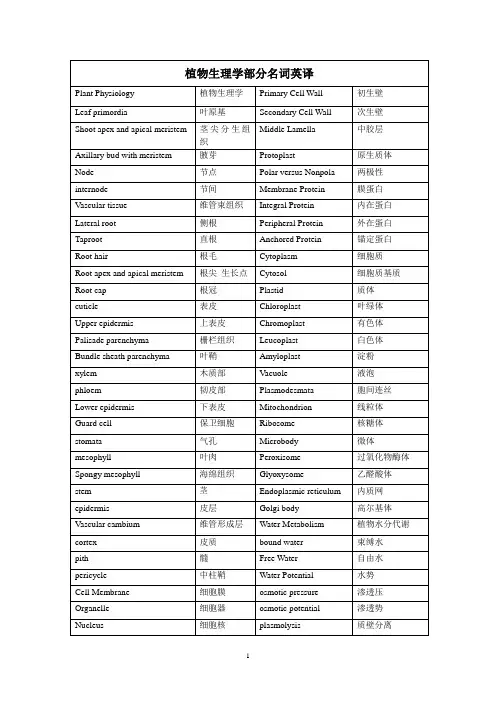
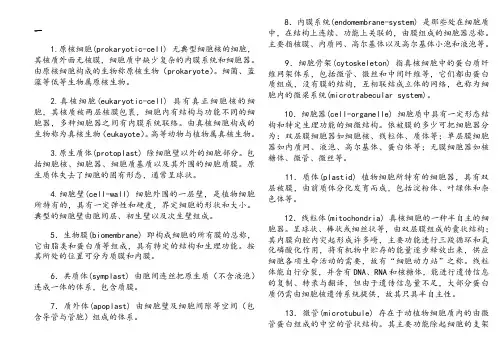
一1.原核细胞(prokaryotic-cell) 无典型细胞核的细胞,其核质外面无核膜,细胞质中缺少复杂的内膜系统和细胞器。
由原核细胞构成的生物称原核生物(prokaryote)。
细菌、蓝藻等低等生物属原核生物。
2.真核细胞(eukaryotic-cell) 具有真正细胞核的细胞,其核质被两层核膜包裹,细胞内有结构与功能不同的细胞器,多种细胞器之间有内膜系统联络。
由真核细胞构成的生物称为真核生物(eukayote)。
高等动物与植物属真核生物。
3.原生质体(protoplast) 除细胞壁以外的细胞部分。
包括细胞核、细胞器、细胞质基质以及其外围的细胞质膜。
原生质体失去了细胞的固有形态,通常呈球状。
4.细胞壁(cell-wall) 细胞外围的一层壁,是植物细胞所特有的,具有一定弹性和硬度,界定细胞的形状和大小。
典型的细胞壁由胞间层、初生壁以及次生壁组成。
5.生物膜(biomembrane) 即构成细胞的所有膜的总称,它由脂类和蛋白质等组成,具有特定的结构和生理功能。
按其所处的位置可分为质膜和内膜。
6.共质体(symplast) 由胞间连丝把原生质(不含液泡)连成一体的体系,包含质膜。
7.质外体(apoplast) 由细胞壁及细胞间隙等空间(包含导管与管胞)组成的体系。
8.内膜系统(endomembrane-system) 是那些处在细胞质中,在结构上连续、功能上关联的,由膜组成的细胞器总称。
主要指核膜、内质网、高尔基体以及高尔基体小泡和液泡等。
9.细胞骨架(cytoskeleton) 指真核细胞中的蛋白质纤维网架体系,包括微管、微丝和中间纤维等,它们都由蛋白质组成,没有膜的结构,互相联结成立体的网络,也称为细胞内的微梁系统(microtrabecular system)。
10.细胞器(cell-organelle) 细胞质中具有一定形态结构和特定生理功能的细微结构。
依被膜的多少可把细胞器分为:双层膜细胞器如细胞核、线粒体、质体等;单层膜细胞器如内质网、液泡、高尔基体、蛋白体等;无膜细胞器如核糖体、微管、微丝等。
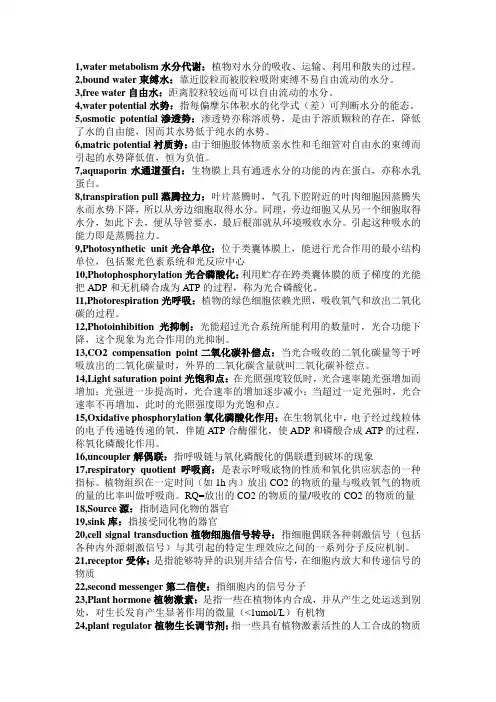
1,water metabolism水分代谢:植物对水分的吸收、运输、利用和散失的过程。
2,bound water束缚水:靠近胶粒而被胶粒吸附束缚不易自由流动的水分。
3,free water自由水:距离胶粒较远而可以自由流动的水分。
4,water potential水势:指每偏摩尔体积水的化学式(差)可判断水分的能态。
5,osmotic potential渗透势:渗透势亦称溶质势,是由于溶质颗粒的存在,降低了水的自由能,因而其水势低于纯水的水势。
6,matric potential衬质势:由于细胞胶体物质亲水性和毛细管对自由水的束缚而引起的水势降低值,恒为负值。
7,aquaporin水通道蛋白:生物膜上具有通透水分的功能的内在蛋白,亦称水乳蛋白。
8,transpiration pull蒸腾拉力:叶片蒸腾时,气孔下腔附近的叶肉细胞因蒸腾失水而水势下降,所以从旁边细胞取得水分。
同理,旁边细胞又从另一个细胞取得水分,如此下去,便从导管要水,最后根部就从环境吸收水分。
引起这种吸水的能力即是蒸腾拉力。
9,Photosynthetic unit光合单位:位于类囊体膜上,能进行光合作用的最小结构单位,包括聚光色素系统和光反应中心10,Photophosphorylation光合磷酸化:利用贮存在跨类囊体膜的质子梯度的光能把ADP和无机磷合成为ATP的过程,称为光合磷酸化。
11,Photorespiration光呼吸:植物的绿色细胞依赖光照,吸收氧气和放出二氧化碳的过程。
12,Photoinhibition光抑制:光能超过光合系统所能利用的数量时,光合功能下降,这个现象为光合作用的光抑制。
13,CO2 compensation point二氧化碳补偿点:当光合吸收的二氧化碳量等于呼吸放出的二氧化碳量时,外界的二氧化碳含量就叫二氧化碳补偿点。
14,Light saturation point光饱和点:在光照强度较低时,光合速率随光强增加而增加;光强进一步提高时,光合速率的增加逐步减小;当超过一定光强时,光合速率不再增加,此时的光照强度即为光饱和点。
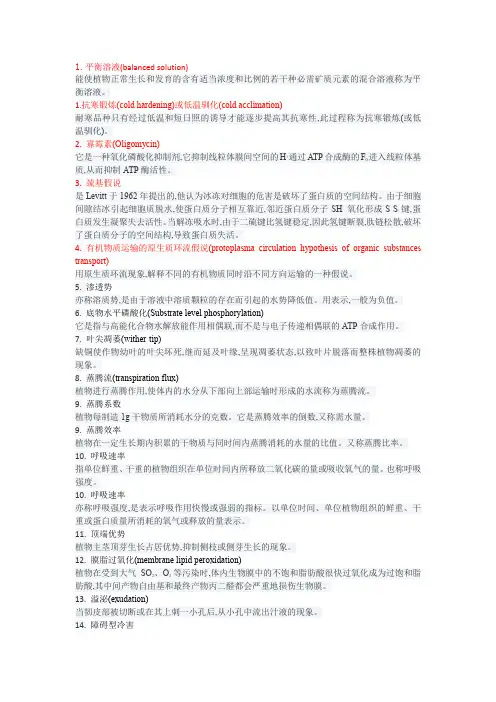
1.平衡溶液(balanced solution)能使植物正常生长和发育的含有适当浓度和比例的若干种必需矿质元素的混合溶液称为平衡溶液。
1.抗寒锻炼(cold hardening)或低温驯化(cold acclimation)耐寒品种只有经过低温和短日照的诱导才能逐步提高其抗寒性,此过程称为抗寒锻炼(或低温驯化)。
2. 寡霉素(Oligomycin)它是一种氧化磷酸化抑制剂,它抑制线粒体膜间空间的H+通过A TP合成酶的F0进入线粒体基质,从而抑制ATP酶活性。
3. 巯基假说是Levitt于1962年提出的,他认为冰冻对细胞的危害是破坏了蛋白质的空间结构。
由于细胞间隙结冰引起细胞质脱水,使蛋白质分子相互靠近,邻近蛋白质分子-SH氧化形成-S-S-键,蛋白质发生凝聚失去活性。
当解冻吸水时,由于二硫键比氢键稳定,因此氢键断裂,肽链松散,破坏了蛋白质分子的空间结构,导致蛋白质失活。
4. 有机物质运输的原生质环流假说(protoplasma circulation hypothesis of organic substances transport)用原生质环流现象,解释不同的有机物质同时沿不同方向运输的一种假说。
5. 渗透势亦称溶质势,是由于溶液中溶质颗粒的存在而引起的水势降低值。
用表示,一般为负值。
6.底物水平磷酸化(Substrate level phosphorylation)它是指与高能化合物水解放能作用相偶联,而不是与电子传递相偶联的ATP合成作用。
7.叶尖凋萎(wither-tip)缺铜使作物幼叶的叶尖坏死,继而延及叶缘,呈现凋萎状态,以致叶片脱落而整株植物凋萎的现象。
8.蒸腾流(transpiration flux)植物进行蒸腾作用,使体内的水分从下部向上部运输时形成的水流称为蒸腾流。
9.蒸腾系数植物每制造1g干物质所消耗水分的克数。
它是蒸腾效率的倒数,又称需水量。
9.蒸腾效率植物在一定生长期内积累的干物质与同时间内蒸腾消耗的水量的比值。
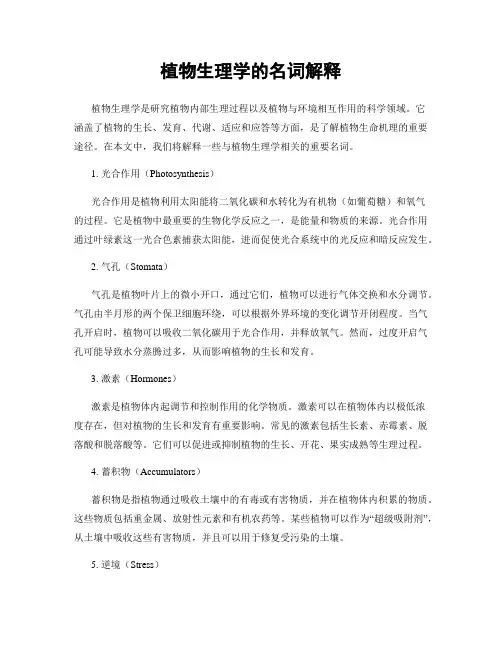
植物生理学的名词解释植物生理学是研究植物内部生理过程以及植物与环境相互作用的科学领域。
它涵盖了植物的生长、发育、代谢、适应和应答等方面,是了解植物生命机理的重要途径。
在本文中,我们将解释一些与植物生理学相关的重要名词。
1. 光合作用(Photosynthesis)光合作用是植物利用太阳能将二氧化碳和水转化为有机物(如葡萄糖)和氧气的过程。
它是植物中最重要的生物化学反应之一,是能量和物质的来源。
光合作用通过叶绿素这一光合色素捕获太阳能,进而促使光合系统中的光反应和暗反应发生。
2. 气孔(Stomata)气孔是植物叶片上的微小开口,通过它们,植物可以进行气体交换和水分调节。
气孔由半月形的两个保卫细胞环绕,可以根据外界环境的变化调节开闭程度。
当气孔开启时,植物可以吸收二氧化碳用于光合作用,并释放氧气。
然而,过度开启气孔可能导致水分蒸腾过多,从而影响植物的生长和发育。
3. 激素(Hormones)激素是植物体内起调节和控制作用的化学物质。
激素可以在植物体内以极低浓度存在,但对植物的生长和发育有重要影响。
常见的激素包括生长素、赤霉素、脱落酸和脱落酸等。
它们可以促进或抑制植物的生长、开花、果实成熟等生理过程。
4. 蓄积物(Accumulators)蓄积物是指植物通过吸收土壤中的有毒或有害物质,并在植物体内积累的物质。
这些物质包括重金属、放射性元素和有机农药等。
某些植物可以作为“超级吸附剂”,从土壤中吸收这些有害物质,并且可以用于修复受污染的土壤。
5. 逆境(Stress)逆境是指植物在环境变化或外部因素的影响下所经历的不利条件。
逆境可以包括干旱、盐碱、高温、寒冷等。
植物通过调节生理过程和产生适应性反应来应对逆境。
这些适应性机制包括细胞保护物质的积累、抗氧化剂的产生、根系和叶片形态的适应性变化等。
6. 受精和授粉(Fertilization and Pollination)受精是指植物的花粉与雌蕊的子房结合,形成种子的过程。
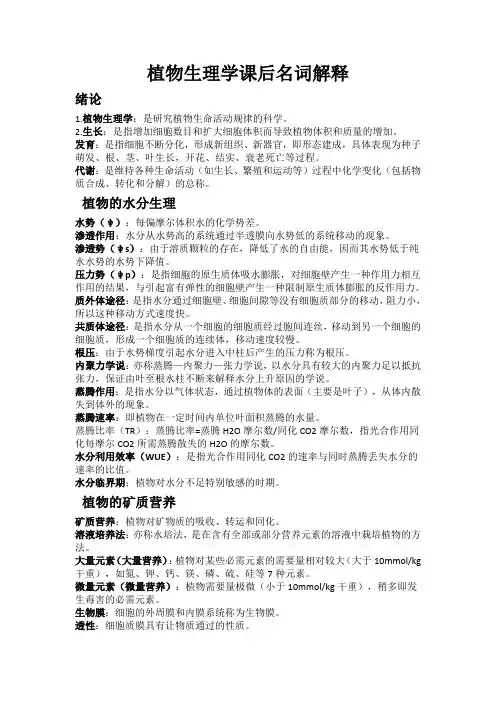
植物生理学课后名词解释绪论1.植物生理学:是研究植物生命活动规律的科学。
2.生长:是指增加细胞数目和扩大细胞体积而导致植物体积和质量的增加。
发育:是指细胞不断分化,形成新组织、新器官,即形态建成,具体表现为种子萌发、根、茎、叶生长,开花、结实、衰老死亡等过程。
代谢:是维持各种生命活动(如生长、繁殖和运动等)过程中化学变化(包括物质合成、转化和分解)的总称。
植物的水分生理水势(ψ):每偏摩尔体积水的化学势差。
渗透作用:水分从水势高的系统通过半透膜向水势低的系统移动的现象。
渗透势(ψs):由于溶质颗粒的存在,降低了水的自由能,因而其水势低于纯水水势的水势下降值。
压力势(ψp):是指细胞的原生质体吸水膨胀,对细胞壁产生一种作用力相互作用的结果,与引起富有弹性的细胞壁产生一种限制原生质体膨胀的反作用力。
质外体途径:是指水分通过细胞壁、细胞间隙等没有细胞质部分的移动,阻力小,所以这种移动方式速度快。
共质体途径:是指水分从一个细胞的细胞质经过胞间连丝,移动到另一个细胞的细胞质,形成一个细胞质的连续体,移动速度较慢。
根压:由于水势梯度引起水分进入中柱后产生的压力称为根压。
内聚力学说:亦称蒸腾—内聚力—张力学说,以水分具有较大的内聚力足以抵抗张力,保证由叶至根水柱不断来解释水分上升原因的学说。
蒸腾作用:是指水分以气体状态,通过植物体的表面(主要是叶子),从体内散失到体外的现象。
蒸腾速率:即植物在一定时间内单位叶面积蒸腾的水量。
蒸腾比率(TR):蒸腾比率=蒸腾H2O摩尔数/同化CO2摩尔数,指光合作用同化每摩尔CO2所需蒸腾散失的H2O的摩尔数。
水分利用效率(WUE):是指光合作用同化CO2的速率与同时蒸腾丢失水分的速率的比值。
水分临界期:植物对水分不足特别敏感的时期。
植物的矿质营养矿质营养:植物对矿物质的吸收、转运和同化。
溶液培养法:亦称水培法,是在含有全部或部分营养元素的溶液中栽培植物的方法。
大量元素(大量营养):植物对某些必需元素的需要量相对较大(大于10mmol/kg 干重),如氮、钾、钙、镁、磷、硫、硅等7种元素。
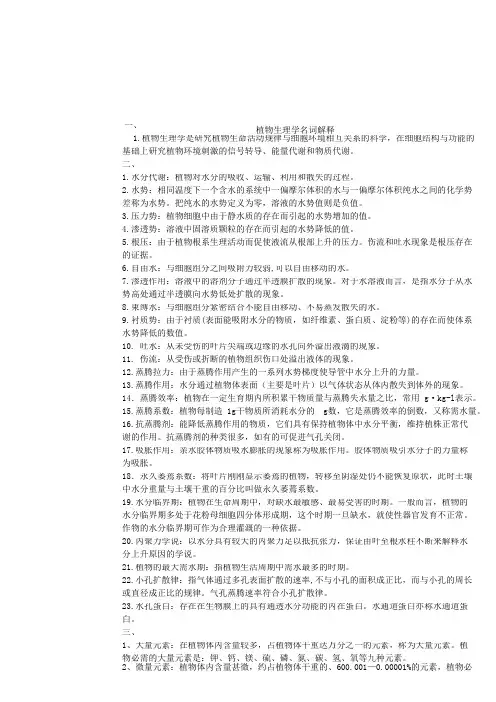
植物生理学名词解释 一、1.植物生理学是研究植物生命活动规律与细胞环境相互关系的科学,在细胞结构与功能的基础上研究植物环境刺激的信号转导、能量代谢和物质代谢。
二、1.水分代谢:植物对水分的吸收、运输、利用和散失的过程。
2.水势:相同温度下一个含水的系统中一偏摩尔体积的水与一偏摩尔体积纯水之间的化学势差称为水势。
把纯水的水势定义为零,溶液的水势值则是负值。
3.压力势:植物细胞中由于静水质的存在而引起的水势增加的值。
4.渗透势:溶液中固溶质颗粒的存在而引起的水势降低的值。
5.根压:由于植物根系生理活动而促使液流从根部上升的压力。
伤流和吐水现象是根压存在的证据。
6.自由水:与细胞组分之间吸附力较弱,可以自由移动的水。
7.渗透作用:溶液中的溶剂分子通过半透膜扩散的现象。
对于水溶液而言,是指水分子从水势高处通过半透膜向水势低处扩散的现象。
8.束缚水:与细胞组分紧密结合不能自由移动、不易蒸发散失的水。
9.衬质势:由于衬质(表面能吸附水分的物质,如纤维素、蛋白质、淀粉等)的存在而使体系水势降低的数值。
10. 吐水:从未受伤的叶片尖端或边缘的水孔向外溢出液滴的现象。
11. 伤流:从受伤或折断的植物组织伤口处溢出液体的现象。
12.蒸腾拉力:由于蒸腾作用产生的一系列水势梯度使导管中水分上升的力量。
13.蒸腾作用:水分通过植物体表面(主要是叶片)以气体状态从体内散失到体外的现象。
14.蒸腾效率:植物在一定生育期内所积累干物质量与蒸腾失水量之比,常用 g ·kg-l 表示。
15.蒸腾系数:植物每制造 1g 干物质所消耗水分的 g 数,它是蒸腾效率的倒数,又称需水量。
16.抗蒸腾剂:能降低蒸腾作用的物质,它们具有保持植物体中水分平衡,维持植株正常代谢的作用。
抗蒸腾剂的种类很多,如有的可促进气孔关闭。
17.吸胀作用:亲水胶体物质吸水膨胀的现象称为吸胀作用。
胶体物质吸引水分子的力量称为吸胀。
18.永久萎蔫系数:将叶片刚刚显示萎蔫的植物,转移至阴湿处仍不能恢复原状,此时土壤中水分重量与土壤干重的百分比叫做永久萎蔫系数。
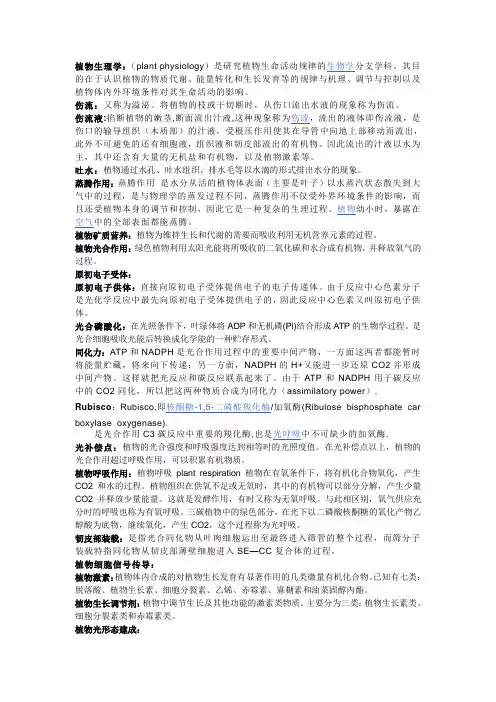
植物生理学:(plant physiology)是研究植物生命活动规律的生物学分支学科。
其目的在于认识植物的物质代谢、能量转化和生长发育等的规律与机理、调节与控制以及植物体内外环境条件对其生命活动的影响。
伤流:又称为溢泌。
将植物的枝或干切断时,从伤口流出水液的现象称为伤流。
伤流液:掐断植物的嫩茎,断面流出汁液,这种现象称为伤流,流出的液体即伤流液,是伤口的输导组织(木质部)的汁液,受根压作用使其在导管中向地上部移动而流出,此外不可避免的还有细胞液,组织液和韧皮部流出的有机物。
因此流出的汁液以水为主,其中还含有大量的无机盐和有机物,以及植物激素等。
吐水:植物通过水孔、吐水组织、排水毛等以水滴的形式排出水分的现象。
蒸腾作用:蒸腾作用是水分从活的植物体表面(主要是叶子)以水蒸汽状态散失到大气中的过程,是与物理学的蒸发过程不同,蒸腾作用不仅受外界环境条件的影响,而且还受植物本身的调节和控制,因此它是一种复杂的生理过程。
植物幼小时,暴露在空气中的全部表面都能蒸腾。
植物矿质营养:植物为维持生长和代谢的需要而吸收利用无机营养元素的过程。
植物光合作用:绿色植物利用太阳光能将所吸收的二氧化碳和水合成有机物,并释放氧气的过程。
原初电子受体:原初电子供体:直接向原初电子受体提供电子的电子传递体。
由于反应中心色素分子是光化学反应中最先向原初电子受体提供电子的,因此反应中心色素又叫原初电子供体。
光合磷酸化:在光照条件下,叶绿体将ADP和无机磷(Pi)结合形成ATP的生物学过程。
是光合细胞吸收光能后转换成化学能的一种贮存形式。
同化力:ATP和NADPH是光合作用过程中的重要中间产物,一方面这两者都能暂时将能量贮藏,将来向下传递;另一方面,NADPH的H+又能进一步还原CO2并形成中间产物。
这样就把光反应和碳反应联系起来了。
由于ATP和NADPH用于碳反应中的CO2同化,所以把这两种物质合成为同化力(assimilatory power). Rubisco:Rubisco,即核酮糖-1,5-二磷酸羧化酶/加氧酶(Ribulose bisphosphate car boxylase oxygenase).是光合作用C3碳反应中重要的羧化酶,也是光呼吸中不可缺少的加氧酶.光补偿点:植物的光合强度和呼吸强度达到相等时的光照度值。
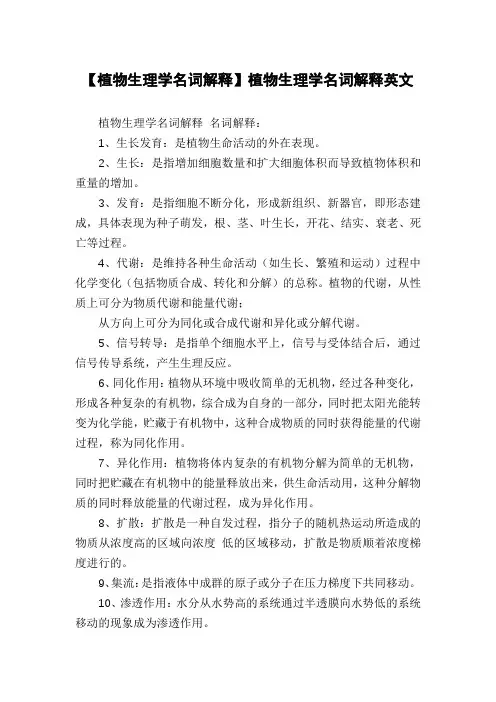
【植物生理学名词解释】植物生理学名词解释英文植物生理学名词解释名词解释:1、生长发育:是植物生命活动的外在表现。
2、生长:是指增加细胞数量和扩大细胞体积而导致植物体积和重量的增加。
3、发育:是指细胞不断分化,形成新组织、新器官,即形态建成,具体表现为种子萌发,根、茎、叶生长,开花、结实、衰老、死亡等过程。
4、代谢:是维持各种生命活动(如生长、繁殖和运动)过程中化学变化(包括物质合成、转化和分解)的总称。
植物的代谢,从性质上可分为物质代谢和能量代谢;从方向上可分为同化或合成代谢和异化或分解代谢。
5、信号转导:是指单个细胞水平上,信号与受体结合后,通过信号传导系统,产生生理反应。
6、同化作用:植物从环境中吸收简单的无机物,经过各种变化,形成各种复杂的有机物,综合成为自身的一部分,同时把太阳光能转变为化学能,贮藏于有机物中,这种合成物质的同时获得能量的代谢过程,称为同化作用。
7、异化作用:植物将体内复杂的有机物分解为简单的无机物,同时把贮藏在有机物中的能量释放出来,供生命活动用,这种分解物质的同时释放能量的代谢过程,成为异化作用。
8、扩散:扩散是一种自发过程,指分子的随机热运动所造成的物质从浓度高的区域向浓度低的区域移动,扩散是物质顺着浓度梯度进行的。
9、集流:是指液体中成群的原子或分子在压力梯度下共同移动。
10、渗透作用:水分从水势高的系统通过半透膜向水势低的系统移动的现象成为渗透作用。
11、伤流:从受伤或折断的植物组织溢出液体的现象,成为伤流。
12、蒸腾作用:是指水分以气体状态,通过植物体的表面(主要是叶子),从体内散失到体外的现象。
13、蒸腾速率:植物在一定时间内单位叶面积蒸腾的水量。
了解蒸腾比率和蒸腾系数。
14、荧光现象:叶绿素溶液在透射光下呈绿色,而在反射光下呈红色,这种现象称为荧光现象。
15、红降:当光波大于685nm(远红光)时,虽然光子仍被叶绿素大量吸收,但量子产额急剧下降,这种现象被称为红降。

植物生理学名词解释全 TPMK standardization office TPMK5AB- TPMK08- TPMK2C- TPMK18一、绪论1.植物生理学是研究植物生命活动规律与细胞环境相互关系(de)科学,在细胞结构与功能(de)基础上研究植物环境刺激(de)信号转导、能量代谢和物质代谢.二、植物(de)水分生理1. 水势:相同温度下一个含水(de)系统中一偏摩尔体积(de)水与一偏摩尔体积纯水之间(de)化学势差称为水势.把纯水(de)水势定义为零,溶液(de)水势值则是负值.水分代谢:植物对水分(de)吸收、运输、利用和散失(de)过程.2.衬质势:由于衬质(表面能吸附水分(de)物质,如纤维素、蛋白质、淀粉等)(de)存在而使体系水势降低(de)数值.3.压力势:植物细胞中由于静水质(de)存在而引起(de)水势增加(de)值.4.渗透势:溶液中固溶质颗粒(de)存在而引起(de)水势降低(de)值.5.渗透作用:溶液中(de)溶剂分子通过半透膜扩散(de)现象.对于水溶液而言,是指水分子从水势高处通过半透膜向水势低处扩散(de)现象.6.质壁分离:植物细胞由于液泡失水而使原生质体和细胞壁分离(de)现象.7.吸胀作用:亲水胶体物质吸水膨胀(de)现象称为吸胀作用.胶体物质吸引水分子(de)力量称为吸胀.8.根压:由于植物根系生理活动而促使液流从根部上升(de)压力.伤流和吐水现象是根压存在(de)证据.9.蒸腾作用:水分通过植物体表面(主要是叶片)以气体状态从体内散失到体外(de)现象. 10.蒸腾效率:植物在一定生育期内所积累干物质量与蒸腾失水量之比,常用g·kg-l表示.11.蒸腾系数:植物每制造1g干物质所消耗水分(de)g数,它是蒸腾效率(de)倒数,又称需水量.12.气孔蒸腾:植物细胞内(de)水分通过气孔进行蒸腾(de)方式称为气孔蒸腾.13.气孔运动主要受保卫细胞(de)液泡水势(de)调节,但调节保卫细胞水势(de)途径比较复杂.14.保卫细胞:新月形(de)细胞,成对分布在植物叶气孔周围,控制进出叶子(de)气体和水分(de)量. 形成气孔和水孔(de)一对细胞.双子叶植物(de)保卫细胞通常是肾形(de)细胞,侧(腹侧)比较厚,而外侧(背侧)比较薄,所以随着细胞内压(de)变化,可进行开闭运动.15.蒸腾拉力:由于蒸腾作用产生(de)一系列水势梯度使导管中水分上升(de)力量.16.水孔蛋白:存在在生物膜上(de)具有通透水分功能(de)内在蛋白.水通道蛋白亦称水通道蛋白.17.内聚力(the cohesion value)又叫粘聚力,是在同种物质内部相邻各部分之间(de)相互吸引力,这种相互吸引力是同种物质分子之间存在分子力(de)表现.18.蒸腾拉力-内聚力-张力学说19.萎焉:水分亏缺严重时,植物细胞因失水而松弛,靠膨压维持挺立状态(de)叶片和茎(de)幼嫩部分下垂,这种现象叫萎焉.20. 暂时萎焉:当蒸腾作用强烈,根系吸水及转运水分(de)速度较慢,不足以弥补蒸腾失水时,发生暂时萎焉,当蒸腾速率降低时,根系吸水(de)水分足以弥补失水,消除水分亏缺,即使不浇水或者通过荫蔽能恢复,这种靠降低蒸腾就能消除(de)萎焉.21.永久萎焉:如果土壤中缺少植物可利用(de)水,永久萎蔫:降低蒸腾仍不能消除水分亏缺恢复原状(de)萎蔫.22..水分临界期:植物在生命周期中,对缺水最敏感、最易受害(de)时期.一般而言,植物(de)水分临界期多处于花粉母细胞四分体形成期,这个时期一旦缺水,就使性器官发育不正常.作物(de)水分临界期可作为合理灌溉(de)一种依据.23.三、植物(de)矿质与氮素营养1.灰分元素:亦称矿质元素.当干燥(de)植物体经过充分燃烧后,会留下一些呈灰白色(de)残渣,这就是所谓(de)灰分.矿质元素以氧化物(de)形式存在于灰分中,将灰分进行化学分析,就会发现其中含有磷、钾、钙、镁、铁、钴等多种元素,通常将这些元素称为灰分元素.2.必需元素:若生物体在缺少某种元素(de)情况下不能维持正常(de)生命活动,重新补充该元素后,生命活动恢复正常,则该元素为必需元素.3.大量元素:在植物体内含量较多,占植物体干重达万分之一(de)元素,称为大量元素.植物必需(de)大量元素是:钾、钙、镁、硫、磷、氮、碳、氢、氧等九种元素.4.微量元素:植物体内含量甚微,约占植物体干重(de)、600.001—0.00001%(de)元素,植物必需(de)微量元素是铁、锰、硼、锌、铜、钼和氯等七种元素,植物对这些元素(de)需要量极微,稍多既发生毒害,故称为微量元素.5.有益元素:6.溶液培养:是在含有全部或部分营养元素(de)溶液中栽培植物(de)方法.7.砂基培养:8.简单扩散:是被动运输(de)基本方式,不需要膜蛋白(de)帮助,也不消耗ATP,而只靠膜两侧保持一定(de)浓度差,通过扩散发生(de)物质运输.简单扩散(de)限制因素是物质(de)脂溶性、分子大小和带电性.9.杜南平衡:细胞内可扩散正负离子浓度乘积等于细胞外液可扩散正负离子浓度乘积时(de)状态.10.易化扩散:是指非脂溶性物质或亲水性物质, 如氨基酸、糖和金属离子等借助细胞膜上(de)膜蛋白(de)帮助顺浓度梯度或顺电化学浓度梯度, 不消耗ATP进入膜内(de)一种运输方式.11.被动运输:是指由于扩散作用或其它物理过程而进行(de)吸收,是不消耗代谢能量(de)吸收过程,故又称为非代谢吸收.12.主动运输:是指细胞利用呼吸释放(de)能量作功而逆着电化学势梯度吸收离子(de)过程.13.生理酸性盐:对于(NH4)2SO4一类盐,植物吸收NH4+较SO4-多而快,这种选择吸收导致溶液变酸,故称这种盐类为生理酸性盐.14.生理碱性盐:对于NaNO3一类盐,植物吸收NO3-较Na+快而多,选择吸收(de)结果使溶液变碱,因而称为生理碱性盐.15.单盐毒害:植物被培养在某种单一(de)盐溶液中,不久即呈现不正常状态,最后死亡.这种现象叫单盐毒害.16.离子拮抗:在单盐溶液中加入少量其它盐类可消除单盐毒害现象,这种离子间相互消除毒害(de)现象为离子拮抗.17.自由空间 free space 指植物组织内(de)某个空间,其外液中(de)物质通过代谢产生(de)能量无消耗地进入这个空间,称此空间为自由空间.18.生物固氮:微生物自生或与植物(或动物)共生,通过体内固氮酶(de)作用,将大气中(de)游离氮固定转化为含氮化合物(de)过程.19.工业固氮:20.硝酸还原酶:一种氧化还原酶,可催化硝酸离子还原成亚硝酸离子(de)反应.可分为参与硝酸盐同化(de)同化型还原酶和催化以硝酸盐为活体氧化(de)最终电子受休(de)硝酸盐呼吸异化型(呼吸型)还原酶.同化型存在于高等植物、藻类、菌类及细菌,小(de)含有2个亚基,大(de)含有8个亚基,是由含钼复合体(Mo-Co)、黄素腺嘌呤二核苷酸(FAD)和正铁血红素(de)亚单位所成(de)酶,即分子内具有小(de)电子递体.21.需肥临界期:对某种元素(de)要求虽然不多,但生理作用强,敏感迫切.此期缺肥将严重影响或抑制植物生长,即使以后弥补,也很难挽回损失.四、植物(de)光合作用1.光合作用:绿色植物吸收阳光(de)能量,同化CO2和H2O,制造有机物质,并释放O2(de)过程.2.光反应:必须在光下才能进行(de),由光引起(de)光化学反应.3.碳反应:在暗处或光处都能进行(de),由若干酶所催化(de)化学反应.4.荧光现象:指叶绿素溶液照光后会发射出暗红色荧光(de)现象.5.吸收光谱:6.作用光谱:7.光合电子传递链:在光合作用中,由传氢体和传电子体组成(de)传递氢和电子(de)系统或途径.8.光系统Ⅰ(PSI):能被波长700nm(de)光激发,又称P700.包含多条肽链,位于基粒与基质接触区和基质类囊体膜中.由集光复合体Ⅰ和作用中心构成.结合100个左右叶绿素分子、除了几个特殊(de)叶绿素为中心色素外,其它叶绿素都是天线色素.三种电子载体分别为A0(一个chla分子)、A1(为维生素K1)及3个不同(de)4Fe-4S.9.光系统Ⅱ(PSⅡ):吸收高峰为波长680nm处,又称P680.至少包括12条多肽链.位于基粒于基质非接触区域(de)类囊体膜上.包括一个集光复合体(light-hawestingcomnplex Ⅱ,LHC Ⅱ)、一个反应中心和一个含锰原子(de)放氧(de)复合体.D1和D2为两条核心肽链,结合中心色素P680、去镁叶绿素及质体醌.10.双增益效应:如果用长波红光(大于685nm)照射和短波红光(650nm)同时照射植物,则光合作用(de)量子产额大增,比单独用这两种波长(de)光照射时(de)总和还要高,这种增益效应称为双增益效应.11.量子产额:指每吸收一个光量子所合成(de)光合产物(de)量或释放(de)氧气(de)量,又称为量子效率.12.光合磷酸化:叶绿体(或载色体)在光下把无机磷和ADP转化为ATP,并形成高能磷酸键(de)过程.13.解偶联作用:所有破坏生物氧化与磷酸化相偶联(de)作用,即抑制氧化磷酸化(de)作用即解偶联作用.14.卡尔文循环:15.Rubisco:1,5-二磷酸核酮糖羧化酶/加氧酶(Ribulose-1,5-bisphosphate carboxylase/oxygenase,通常简写为RuBisCO)是一种酶(EC 4.1.1.39),分子量约为53kD,由8个大亚基和8个小亚基组成,是光合作用中决定碳同化速率(de)关键酶.它在光合作用中卡尔文循环里催化第一个主要(de)碳固定反应,将大气中游离(de)二氧化碳转化为生物体内储能分子,比如蔗糖分子.1,5-二磷酸核酮糖羧化酶/加氧酶可以催化1,5-二磷酸核酮糖与二氧化碳(de)羧化反应或与氧气(de)氧化反应.同时RuBisCO也能使RuBP进入光呼吸途径. 同时,它(de)活性也由光照影响,在暗处,rubisco(de)活性受到抑制,这也是为什么在黑暗时,碳反应难以进行(de)原因.16.磷酸运转体:17.光呼吸:)是所有使用卡尔文循环进行碳固定(de)细胞在光照和高氧低二氧化碳情况下发生(de)一个生化过程.它是卡尔文循环中一个损耗能量(de)副反应.过程中氧气被消耗,并且会生成二氧化碳.18.C4途径:有一些植物对CO2(de)固定反应是在叶肉细胞(de)胞质溶胶中进行(de),在磷酸烯醇式丙酮酸羧化酶(de)催化下将CO2连接到磷酸烯醇式丙酮酸(PEP)上·形成四碳酸:草酰乙酸(oxaloacetate),这种固定CO2(de)方式称为C4途径.C4植物每同化1分子CO2,需要消耗5分子ATP和2分子NADPH.19.CAM途径:即为景天酸代谢途径.景天科植物晚上气孔开放,吸进CO2,在PEP羧化酶作用下,形成草酰乙酸,进一步还原为苹果酸,积累于液泡中.白天气孔关闭,液泡中(de)苹果酸便运到细胞溶质,在NADP苹果酸酶作用下,氧化脱羧,放出CO2,参与卡尔文循环,形成淀粉等.这种最初CO2固定和碳水化合物合成(de)反应分别在夜间及昼间进行,苹果酸合成日变化(de)代谢途径.20.CO2饱和点:在一定范围内,光合速率随着CO2浓度增加而增加,当光合速率不再继续增加时(de)CO2浓度称为CO2饱和点.21.CO2补偿点,当光合吸收(de)CO2量与呼吸释放(de)CO2量相等时,外界(de)CO2浓度.22.光饱和点:在一定范围内,光合速率随着光照强度(de)增加而加快,光合速率不再继续增加时(de)光照强度称为光饱和点.23.光补偿点:指同一叶子在同一时间内,光合过程中吸收(de)CO2和呼吸过程中放出(de)CO2等量时(de)光照强度.24.光能利用率:单位面积上(de)植物通过光合作用所累积(de)有机物中所含(de)能量,占照射在相同面积地面上(de)日光能量(de)百分比.五、植物呼吸作用1.呼吸作用:指生活细胞内(de)有机物质,在一系列酶(de)参与下,逐步氧化分解,同时释放能量(de)过程.2.有氧呼吸:指生活细胞在氧气(de)参与下,把某些有机物质彻底氧化分解,放出CO2并形成水,同时释放能量(de)过程.3.无氧呼吸:指在无氧条件下,细胞把某些有机物分解为不彻底(de)氧化产物.4.发酵作用:指微生物厌氧或兼性厌氧微生物在厌氧(de)条件下以某些有机化合物作为末端氢(电子)受体,氧化降解有机物获得能量(de)过程.5.糖酵解:是指在细胞质内所发生(de)、由葡萄糖分解为丙酮酸(de)过程.6.三羧酸循环:丙酮酸在有氧条件下,通过一个包括三羧酸和二羧酸(de)循环而逐步氧化分解生成CO2(de)过程.又称为柠像酸环或Krebs环,简称TCA循环.7.戊糖磷酸途径:简称PPP或HMP.是指在细胞质内进行(de)一种葡萄糖直接氧化降解(de)酶促反应过程.8.呼吸电子传递链(respiratory electron-transport chain):由一系列可作为电子载体(de)酶复合体和辅助因子构成,可将来自还原型辅酶或底物(de)电子传递给有氧代谢(de)最终(de)电子受体分子氧.9.末端氧化酶:是指处于生物氧化作用一系列反应(de)最末端,将底物脱下(de)氢或电子传递给氧,并形成H2O或H2O2(de)氧化酶类.10.抗氰呼吸:某些植物组织对氰化物不敏感(de)那部分呼吸.即在有氰化物存在(de)情况下仍能够进行其它(de)呼吸途径.11.交替氧化途径:12.氧化磷酸化:是指呼吸链上(de)氧化过程,伴随着ADP被磷酸化为ATP(de)作用.13.巴斯德效应:氧可以降低糖类(de)分解代谢和减少糖酵解产物(de)积累(de)现象叫巴斯德效应14.呼吸速率:又称呼吸强度.以单位鲜重千重或单位面积在单位时间内所放出(de)CO2(de)重量(或体积)或所吸收O2(de)重量(或体积)来表示.15.呼吸商:又称呼吸系数.是指在一定时间内,植物组织释放CO2(de)摩尔数与吸收氧(de)摩尔数之比.16.磷氧比;指呼吸链中每消耗1个氧原子与用去Pi或产生ATP(de)分子数.17.能荷:能荷是指细胞中可利用(de)高能磷酸化合物(de)摩尔数与细胞中总(de)腺苷磷酸(de)比值,细胞中能荷高低对呼吸速率具有(de)调节作用称为能荷调节.18.呼吸跃变:指花朵、果实发育到一定程度时,其呼吸强度突然增高,尔后又逐渐下降(de)现象.19.种子含水量:六同化物(de)运输、分配及信号(de)转导1、共质体:是通过胞间连丝把无数原生质体联系起来形成一个连续(de)整体.2、质外体:是一个开放性(de)连续自由空间,包括细胞壁、细胞间隙及导管等.3、代谢源:指制造并输送有机物质到其他器官(de)组织、器官或部位.如成熟(de)叶片.4、代谢库:指植物接受有机物质用于生长、消耗或贮藏(de)组织,器官或部位.如正在发育(de)种子、果实等.5、胞间连丝:是贯穿胞壁(de)管状结构物,内有连丝微管,其两端与内质网相连接.6、转移细胞:7、同化物分配:8、同化物再分配:9、压力流动学说:压力流动学说:又叫集流学说,是德国人明希提出(de).该学说认为从源到库(de)筛管通道中存在着一个单向(de)呈密集流动(de)液流,其流动动力是源库之间(de)压力势差.10.比集转运速率:比质量转移率——单位时间内通过单位韧皮部横切面积运输(de)干物质量:比质量转移率(SMTR)= 运输(de)物质干重/韧皮部(de)横断面积×时间七植物生长物质1、植物激素:是由植物本身合成(de),数量很少(de)一些有机化合物.它们能从生成处运输到其他部位,在极低(de)浓度下即能产生明显(de)生理效应,可以对植物(de)生长发育产生很大(de)影响.2、植物生长调节剂:是由人工合成(de),在很低浓度下能够调控植物生长发育(de)化学物质.它们具有促进插枝生根,调控开花时间,塑造理想株形等作用.3、植物生长物质:是在较低浓度(de)情况下能对植物产生明显生理作用(de)化学物质,主要包括内源(de)植物激素与人造(de)植物生长调节剂.4、生长素燕麦测定法:以燕麦芽鞘(de)伸长,来表示对生长促进物质(de)敏感反应,生长素(de)定量法.5、生长素极性运输:是指生长素只能从植物体(de)形态学上端向下端运输.6、吲哚乙酸酶:7、酸生长理论:“酸生长理论”(de)要点是:①原生质膜上存在着非活化(de)质子泵(H+-ATP酶),生长素作为泵(de)变构效应剂,与泵蛋白结合后使其活化;②活化了(de)质子泵消耗能量(ATP),将细胞内(de)H+泵到细胞壁中,导致细胞壁基质溶液(de)pH下降;③在酸性条件下,H+一方面使细胞壁中对酸不稳定(de)键(如氢键)断裂,另一方面(也是主要(de)方面)使细胞壁中(de)某些多糖水解酶(如纤维素酶)活化或增加,从而使连接木葡聚糖与纤维素微纤丝之间(de)键断裂,细胞壁松弛;④细胞壁松弛后,细胞(de)压力势下降,导致细胞(de)水势下降,细胞吸水,体积增大而发生不可逆增长.酸生长理论用来解释生长素(de)作用机理.8、吲哚乙酸结合蛋白:9、赤霉素:赤霉素,是广泛存在(de)一类植物激素.其化学结构属于二萜类酸,由四环骨架衍生而得.可刺激叶和芽(de)生长.已知(de)赤霉素种类至少有38种.赤霉素应用于农业生产,在某些方面有较好效果.例如提高无籽葡萄产量,打破马铃薯休眠;在酿造啤酒时,用GA3来促进制备麦芽糖用(de)大麦种子(de)萌发;当晚稻遇阴雨低温而抽穗迟缓时,用赤霉素处理能促进抽穗;或在杂交水稻制种中调节花期以使父母本花期相遇等.10、细胞分裂素:细胞分裂素(cytokinin, CTK)从玉米或其他植物中分离或人工合成(de)植物激素.一般在植物根部产生,是一类促进胞质分裂(de)物质,促进多种组织(de)分化和生长.与植物生长素有协同作用.是调节植物细胞生长和发育(de)植物激素.在细胞分裂中起活化作用,也包含在细胞生长和分化及其他相关(de)生理活动过程中,如激动素(KT)、玉米素(ZT)、6-苄基氨基嘌呤(6-BA)等.11、激动素:激动素是一种非天然(de)细胞分裂素,化学名称为6-糖基氨基嘌呤(或N6-呋喃甲基腺嘌呤),分子式C10H9N5O.不溶于水,溶于强酸、碱及冰醋酸中;除具有促进细胞分裂(de)作用外,还具有延缓离体叶片和切花衰老,诱导芽分化和发育及增加气孔开度(de)作用.12、脱落酸:指能引起芽休眠、叶子脱落和抑制细胞生长等生理作用(de)植物激素.一种抑制生长(de)植物激素,因能促使叶子脱落而得名.可能广泛分布于高等植物.除促使叶子脱落外尚有其他作用,如使芽进入休眠状态、促使马铃薯形成块茎等.对细胞(de)延长也有抑制作用.13、乙烯:乙烯是由两个碳原子和四个氢原子组成(de)化合物.两个碳原子之间以双键连接.乙烯存在于植物(de)某些组织、器官中,是由蛋氨酸在供氧充足(de)条件下转化而成(de).生理作用是:三重反应、促进果实成熟、促进叶片衰老、诱导不定根和根毛发生、打破植物种子和芽(de)休眠、抑制许多植物开花(但能诱导、促进菠萝及其同属植物开花)、在雌雄异花同株植物中可以在花发育早期改变花(de)性别分化方向等.14、油菜素内脂:油菜素内酯又称芸薹素内酯,是一种天然植物激素,广泛存在于植物(de)花粉、种子、茎和叶等器官中.由于其生理活性大大超过现有(de)五种激素,已被国际上誉为第六激素.属新型广谱植物生长调节剂.15、乙烯利:乙烯利,有机化合物,纯品为白色针状结晶,工业品为淡棕色液体,易溶于水,甲醇、丙酮、乙二醇、丙二醇,微溶于甲苯,不溶于石油醚.用作农用植物生长刺激剂. 乙烯利是优质高效植物生长调节剂,具有促进果实成熟,刺激伤流,调节性别转化等效应. 16、ACC:1-氨基环丙烷-1-羧酸.ACC不仅对植物,例如水稻、蔬菜等,而且对动物,例如家蚕、小白鼠等具有优良(de)生理调控作用,是一种新型(de)动、植物双重生长调节剂. 17、三重反应:乙烯可抑制黄化豌豆幼苗上胚轴(de)伸长生长,促进其加粗生长,地上部分失去负向地性生长(偏上生长).18、激素受体:位于细胞表面或细胞内,结合特异激素并引发细胞响应(de)蛋白质.19、结合蛋白:结合蛋白质:结合蛋白质是单纯蛋白质和其他化合物结合构成,被结合(de)其他化合物通常称为结合蛋白质(de)非蛋白部分(辅基).按其非蛋白部分(de)不同而分为核蛋白(含核酸)、糖蛋白(含多糖)、脂蛋白(含脂类)、磷蛋白(含磷酸)、金属蛋白(含金属)及色蛋白(含色素)等.20、乙烯受体:21、生长素:即吲哚乙酸,是最早发现(de)促进植物生长(de)激素.22、生长延缓剂:生长延缓剂(growth retardant),是指那些对植物茎端、亚顶端分生细胞或初生、分生细胞(de)细胞分裂有抑制作用(de)人工合成(de)有机物.23、生长抑制剂:抑制顶端分生组织组织生长,使植物丧失顶端优势,植物形态发生很大变化(de)物质.八植物(de)生长生理1、生长:2、分化:分生组织(de)幼嫩细胞发育成为具有各种形态结构和生理代谢功能(de)成形细胞(de)过程.3、4、发育:5、极性:极性:指在器官、组织甚至细胞中在不同(de)轴向上存在某种形态结构和生理生化上(de)梯度差异.6、生长大周期:在植物生长过程中,无论是细胞、器官或整个植株(de)生长速率都表现出慢——快——慢(de)规律.即开始时生长缓慢,以后逐渐加快,达到最高点后又减缓以至停止.生长(de)这三个阶段总合起来叫做生长大周期(grand period of growth).如果以时间为横坐标,生长量为纵坐标,则植物(de)生长呈“S”形曲线.7、生长曲线:如果以植物(或器官)体积对时间作图 ,可得到植物(de)生长曲线.生长曲线表示植物在生长周期中(de)生长变化趋势,典型(de)有限生长曲线呈S形.如果用干重、高度、表面积、细胞数或蛋白质含量等参数对时间作图,亦可得到同样类型(de)生长曲线.根据S形曲线可将植物生长分成三个时期,即指数期(logarithmic phase)、线性期(linear phase)和衰减期(senescence phase).在指数期绝对生长速率是不断提高(de),而相对生长速率则大体保持不变;在线性期绝对生长速率为最大,而相对生长速率却是递减(de);在衰减期生长逐渐下降,绝对与相对生长速率均趋向于.8、三基点温度:温度三基点是作物生命活动过程(de)最适温度,最低温度和最高温度(de)总称.在最适温度下,作物生长发育迅速而良好;在最高和最低温度下,作物停止生长发育,但仍能维持生命.如果继续升高或降低,就会对作物产生不同程度(de)危害,直至死亡.9、相对生长:相对生长 relative growth 指生物体(de)整体生长与部分(器官)生长、体重与身长、或某一部分(de)生长与其他部分生长(de)相对关系.10、顶端优势:顶芽优先生长,而侧芽生长受抑制(de)现象.11、根冠比:是指植物地下部分与地上部分(de)鲜重或干重(de)比值.它(de)大小反映了植物地下部分与地上部分(de)相关性;在作物苗期,为了给作物创造良好营养生长条件,要促进根系生长,增大根冠比.具体措施有:创造良好(de)土壤条件、中耕断根、蹲苗等措施,肥水措施是:施磷肥,控水.12、营养生长:营养生长指植物根、茎、叶等营养器官(de)发生、增长过程.13、生殖生长:当植物生长到一定时期以后,便开始分化形成花芽,以后开花、授粉、受精、结果(实),形成种子.植物(de)花、果实、种子等生殖器官(de)生长,叫做生殖生长.14、昼夜周期性:植物(de)生长速率按昼夜变化发生(de)有规律(de)变化,为昼夜周期性.影响植物昼夜生长(de)因素主要是温度、水分和光照.在一天(de)进程中,由于昼夜(de)光照强度和温度高低不同,体内(de)含水量也不相同,因此就使植物(de)生长表现出昼夜周期性15、生物钟:又称生理钟,指植物内生节奏调节(de)近似24小时(de)周期性变化节律.16、向性运动:由外界刺激而产生,运动方向取决于外界(de)刺激方向.17、感性运动:由外界刺激或内部时间机制而引起(de),外界刺激方向不能决定运动方向.九植物(de)成花生理1、花熟态:植物能感受外界刺激而诱导开花(de)一种生理状态,称为花熟状态.2、一年生植物:一年生植物是植物生活型(de)一种,指在一年期间发芽、生长、开花然后死亡(de)植物.此类植物皆为草本,因此又常称为一年生草本(植物).3、多年生植物:多年生植物是寿命超过两年以上(de)植物.由于木本植物皆为多年生,本词通常仅指多年生(de)草本植物,又称多年生草本(植物)、多年草等.。
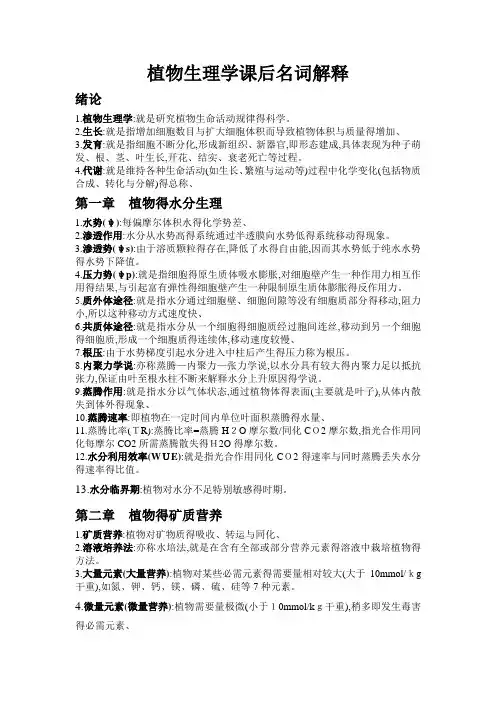
植物生理学课后名词解释绪论1.植物生理学:就是研究植物生命活动规律得科学。
2.生长:就是指增加细胞数目与扩大细胞体积而导致植物体积与质量得增加、3.发育:就是指细胞不断分化,形成新组织、新器官,即形态建成,具体表现为种子萌发、根、茎、叶生长,开花、结实、衰老死亡等过程。
4.代谢:就是维持各种生命活动(如生长、繁殖与运动等)过程中化学变化(包括物质合成、转化与分解)得总称、第一章植物得水分生理1.水势(ψ):每偏摩尔体积水得化学势差、2.渗透作用:水分从水势高得系统通过半透膜向水势低得系统移动得现象。
3.渗透势(ψs):由于溶质颗粒得存在,降低了水得自由能,因而其水势低于纯水水势得水势下降值。
4.压力势(ψp):就是指细胞得原生质体吸水膨胀,对细胞壁产生一种作用力相互作用得结果,与引起富有弹性得细胞壁产生一种限制原生质体膨胀得反作用力。
5.质外体途径:就是指水分通过细胞壁、细胞间隙等没有细胞质部分得移动,阻力小,所以这种移动方式速度快、6.共质体途径:就是指水分从一个细胞得细胞质经过胞间连丝,移动到另一个细胞得细胞质,形成一个细胞质得连续体,移动速度较慢、7.根压:由于水势梯度引起水分进入中柱后产生得压力称为根压。
8.内聚力学说:亦称蒸腾—内聚力—张力学说,以水分具有较大得内聚力足以抵抗张力,保证由叶至根水柱不断来解释水分上升原因得学说。
9.蒸腾作用:就是指水分以气体状态,通过植物体得表面(主要就是叶子),从体内散失到体外得现象、10.蒸腾速率:即植物在一定时间内单位叶面积蒸腾得水量、11.蒸腾比率(TR):蒸腾比率=蒸腾H2O摩尔数/同化CO2摩尔数,指光合作用同化每摩尔CO2所需蒸腾散失得H2O得摩尔数。
12.水分利用效率(WUE):就是指光合作用同化CO2得速率与同时蒸腾丢失水分得速率得比值。
13.水分临界期:植物对水分不足特别敏感得时期。
第二章植物得矿质营养1.矿质营养:植物对矿物质得吸收、转运与同化、2.溶液培养法:亦称水培法,就是在含有全部或部分营养元素得溶液中栽培植物得方法。
1.温室效应(Greenhouse effect):阳光通过短波辐射到地表,使地面及物体温度升高,以长波辐射形式返回散失热量,但由于温室气体(二氧化碳、甲烷等)不能透过长波辐射,使辐射出去的能量有反射回来,地球散失的能量减少,地球变暖。
这种效应类似温室。
2.Reaction center pigments中心色素又名陷井——少数特殊状态的叶绿素a,吸收集光色素传递而来的激发能后,发生光化学反应引起电荷分离的光合色素。
3.Light harvesting pigments (Antenna pigments)集光色素或天线色素——只起吸收和传递光能的作用,不进行光化学反应的光合色素,包括叶绿素b,类胡萝卜素,大部分叶绿素a。
4.Photosynthetic chain光合链是类囊体膜上由两个光系统(PSⅠ、PSⅡ)和若干电子传递体,按一定的氧化还原电位依次排列而成的电子传递系统。
◇注:光合链的主要成分:1.PSⅡ及其集光色素复合体(LHCⅡ)2.PSI及其集光色素复合体(LHCI)3.细胞色素复合体(含Cytf、Cytb6和Fe-S蛋白)4.偶联因子复合体(又名ATP合成酶)5.PQ shutterPQ穿梭:在光合电子传递过程中PQ使间质中H+不断转入类囊体腔,导致间质pH 上升,形成跨膜的质子梯度。
◇注:PQ(质体醌或质醌):担负着传递氢(H+和e-)的任务。
6.Photophosphorylation光合磷酸化:绿色植物光下催化ADP和Pi形成ATP的过程。
◇注:包括非环式PSP、环式PSP和假环式PSP.7.Assimilatory power光合作用前两阶段结束形成活跃的化学能ATP和NADPH合称为“同化力”。
8.Photorespiration光呼吸:是指高等植物的绿色细胞在光下吸收O2放出CO2的过程。
◇注:光呼吸底物——乙醇酸glycolic acid;条件--光;乙醇酸的生物合成及其氧化代谢过程,完成全过程依次涉及到叶绿体、过氧化物体和线粒体三种细胞器。
中英互译水势(water potential渗透势(osmotic potential溶质势(solute potential蒸腾作用(transpiration)光合作用(photosynthesis原初反应(primary reaction)光合单位(photosynthetic unit)光补偿点(Light Compensation Point,LCP)光抑制(photoinhibition)CO2补偿点(CO2 compensa-tion point)末端氧化酶(terminal oxidase)长日植物(long-day plant,LDP)短日植物(short-day plant,SDP)日中性植物(day-neutral plant,DNP)植物生理学(plant physiology)质膜(plasma membrane)内膜系统(endomembrane system)内质网(endoplasmic reticulum)高尔基体(Golgi body)液泡(vacuole)过氧化物酶体(peroxisome)乙醛酸循环体(glyoxysome)细胞核(cell nucleus)线粒体(mitochondrion)质体(plastid)白色体(leucoplast)叶绿体(chloroplast)有色体(chromoplast)细胞质基质(cytoplasmic matrix)细胞骨架(cytoskeleton)胞间连丝(plasmodesma)共质体(symplast)质外体(apoplast)扩散作用(diffusion)渗透作用(osmosis)压力势(pressure potential衬质势(matrix potential水孔蛋白(aquaporin)蒸腾速率(transpiration rate)蒸腾比率(transpiration ratio)蒸腾系数(transpiration coefficient)内聚力学说(cohesion theory)矿质营养(mineral nutrition)矿质元素(mineral element)灰分元素(ash element)必需元素(essential element)溶液培养法(solution culture method)水培法(hydroponics)砂基培养法(sand culture method) 有益元素(benefieial element)。
17年:15. NR:硝酸还原酶16. Pfr:远红光吸收性光敏色素17. Photomorphogenesis:光形态建成18. ROS:反应性氧种19. PCD:细胞程序性死亡20. Plant stress tolerance:植物胁迫耐受性16年:14. LEA:胚发生晚期丰富蛋白15. Rubisco:RuBP羧化酶/加氧酶(核酮糖-1,5-二磷酸羧化酶)15年:PSⅠ: 吸收长波红光(700nm)的光系统ⅠRuBpCase : RuBP羧化酶/加氧酶(核酮糖-1,5-二磷酸羧化酶)SE-CC : 筛管分子-伴胞复合体Salicylic acid :SA,水杨酸Phytochrome :光敏色素PCD : 细胞程序性死亡HSP : 热激蛋白/热休克蛋白Alternative oxidase :AOX,交替氧化酶Reactive oxygen species : ROS,反应性氧种Late embrogenesis abundant protein : LEA:胚发生晚期丰富蛋白1. ETH:乙烯2. MTS:金属硫蛋白3. PSI:吸收长波红光(700nm)的光系统Ⅰ4. POD:过氧化物酶5. NR:硝酸还原酶6. CaM:钙调素7. Pr:红光吸收性光敏素色8. JA:茉莉酸9. PCD:细胞程序性死亡10. GA:赤霉素11. ABA:脱落酸12. SOD:超氧化物歧化酶13. DNP:日中性植物14. ROS:Reactive oxygen species:反应性氧种15. Plant physiology:植物生理学10年:1. NiR :亚硝酸还原酶2. PEPCase:磷酸烯醇式丙酮酸羧化酶3. Patch clamp technique :膜片钳技术4. AQP:水孔蛋白5. Seed longevity :种子的寿命6. BSC:维管束鞘细胞7. ROS :Reactive oxygen species:反应性氧种8. Photophosphorylation:光和磷酸化9. S-3307 :烯效唑10. LDP:长日植物11. Cryptochrome :隐花色素12. Osmotic potential:渗透势13. Respiratory climacteric :呼吸跃变14. EMP-TCA:糖酵解-三羧酸途径15. P/O :磷氧比16. RWC:相对含水量17. Beneficial elements :有益元素18. Cross adaption :交叉适应09年:1. EFE :乙烯形成酶2. TIBA:三碘苯甲酸3. Vernalization :春化作用4. 1O2:含氧非自由基5. Aquaporins :水通道蛋白6. SOD:超氧化物歧化酶7. RWC :相对含水量8. φS:溶质势9. Pfr :远红光吸收性光敏色素10. Rubisco:RuBP羧化酶/加氧酶(核酮糖-1,5-二磷酸羧化酶)11. Stress proteins :胁迫蛋白12. PSⅡ:吸收短波红光(680nm)的光系统Ⅱ13. NR :硝酸还原酶14. CO2 compensation point :CO2补偿点15. Respiratory quotient :呼吸商16. R/T:根冠比17. Photoperidism :光周期现象18. Triple action三重反应08年:1. LDP :长日植物2. SOD:Reactive oxygen species:反应性氧种3. NiR :亚硝酸还原酶4. TCA: 三羧酸循环5. NAA :萘乙酸6. GOGAT:谷氨酰胺-α-酮戊二酸转氨酶7. PSⅠ:吸收长波红光(700nm)的光系统Ⅰ8. ABA:脱落酸9. φπ :渗透势10. NR:硝酸还原酶11. DNP :日中性植物12. IAA:吲哚乙酸13. phytochrome :光敏色素14. photosynthetic yield:光合产物15. plant physiology :植物生理学16. photoperiodism:光周期现象17. plant growth substance :植物生长物质18. pressure flow theory:压力流动学说19. programmed cell death(PCD):程序性细胞死亡20. heat shock proein(HSP):热激蛋白07年:1. EFE :乙烯形成酶2. TIBA:三碘苯甲酸3. Mpa :兆帕4. Pas:多胺类5. 1O2 :含氧非自由基6. CAT:过氧化氢酶7. Ψw: 水势8. Phytochrome :光敏色素9. Rubisco :RuBP羧化酶/加氧酶(核酮糖-1,5-二磷酸羧化酶)10. Proton motive force(pmf):质子动力势11. RQ:呼吸商12. TCA:三羧酸循环13. PQ :质体醌14. Pn:净光合速率15. BSC :维管束鞘细胞16. GS:谷氨酰胺合成酶17. NiR :亚硝酸还原酶18. Photoperiodism :光周期现象19. Physiological dormancy :生理休眠20. After ripening:后熟06年:1.PSII:吸收短波红光(680nm)的光系统Ⅱ2.PEPCase:磷酸烯醇式丙酮酸羧化酶3.CAM:钙调素4.EMP:糖酵解5.ACC:1-氨基环丙烷-1-羧酸6.HSPs:热激蛋白7.Pn:净光合速率8.NAA:萘乙酸9.PP333:多效唑10.ABA :脱落酸11.NR :硝酸还原酶12.GAs:赤霉素类13.Pfr:远红光吸收性光敏色素14.co-transport:共运输15.Aquaporins:水孔蛋白16.Chilling injury:冷害17.Vernalization:春化作用18.Development:发育19.Plant physiology:植物生理学20.Active transport:主动运输05年:1. NiR :亚硝酸还原酶2. PEP :磷酸烯醇式丙酮酸3. Rubisco:RuBP羧化酶/加氧酶(核酮糖-1,5-二磷酸羧化酶)4. rate of growth:生长速率5. P680 :叶绿素a二聚体6806. LEA :胚发生晚期丰富蛋白7. ATPase :ATP磷酸水解酶8. CO2 compensation point:CO2补偿点9. Ψs :溶质势10. LDP :长日植物11. Pfr:远红光吸收性光敏色素12. environmental stress:环境胁迫13. Fd :铁氧还蛋白14. IAA:吲哚乙酸15. C/N :碳氮比16. Plant Physiology :植物生理17. GAs:赤霉素类18. SI (self incompatibility) :自交不亲和性19. RQ (respiratory quotient) :呼吸商20. Water channel proteins or aquaporins :水孔蛋白01年:1. Photomorphogenesis:光形态建成2. Vernalization:春化作用3. Tissue culture:组织培养4. Circadian rhythm:近似昼夜节律5. Stress:胁迫6. Hill reaction:希尔反应。
植物生理学名词解释(双语)
1,water metabolism水分代谢:植物对水分的吸收、运输、利用和散失的过程。
2,bound water束缚水:靠近胶粒而被胶粒吸附束缚不易自由流动的水分。
3,free water自由水:距离胶粒较远而可以自由流动的水分。
4,water potential水势:指每偏摩尔体积水的化学式(差)可判断水分的能态。
5,osmotic potential渗透势:渗透势亦称溶质势,是由于溶质颗粒的存在,降低了水的自由能,因而其水势低于纯水的水势。
6,matric potential衬质势:由于细胞胶体物质亲水性和毛细管对自由水的束缚而引起的水势降低值,恒为负值。
7,aquaporin水通道蛋白:生物膜上具有通透水分的功能的内在蛋白,亦称水乳蛋白。
8,transpiration pull蒸腾拉力:叶片蒸腾时,气孔下腔附近的叶肉细胞因蒸腾失水而水势下降,所以从旁边细胞取得水分。
同理,旁边细胞又从另一个细胞取得水分,如此下去,便从导管要水,最后根部就从环境吸收水分。
引起这种吸水的能力即是蒸腾拉力。
9,Photosynthetic unit光合单位:位于类囊体膜上,能进行光合作用的最小结构单位,包括聚光色素系统和光反应中心
10,Photophosphorylation光合磷酸化:利用贮存在跨类囊体膜的质子梯度的光能把ADP和无机磷合成为ATP的过程,称为光合
磷酸化。
11,Photorespiration光呼吸:植物的绿色细胞依赖光照,吸收氧气和放出二氧化碳的过程。
12,Photoinhibition光抑制:光能超过光合系统所能利用的数量时,光合功能下降,这个现象为光合作用的光抑制。
13,CO2compensation point二氧化碳补偿点:当光合吸收的二氧化碳量等于呼吸放出的二氧化碳量时,外界的二氧化碳含量就叫二氧化碳补偿点。
14,Light saturation point光饱和点:在光照强度较低时,光合速率随光强增加而增加;光强进一步提高时,光合速率的增加逐步减小;当超过一定光强时,光合速率不再增加,此时的光照强度即为光饱和点。
15,Oxidative phosphorylation氧化磷酸化作用:在生物氧化中,电子经过线粒体的电子传递链传递的氧,伴随ATP合酶催化,使ADP和磷酸合成ATP的过程,称氧化磷酸化作用。
16,uncoupler解偶联:指呼吸链与氧化磷酸化的偶联遭到破坏的现象
17,respiratory quotient呼吸商:是表示呼吸底物的性质和氧化供应状态的一种指标。
植物组织在一定时间(如1h内)放出CO2的物质的量与吸收氧气的物质的量的比率叫做呼吸商。
RQ=放出的CO2的物质的量/吸收的CO2的物质的量18,Source源:指制造同化物的器官
19,sink库:指接受同化物的器官
20,cell signal transduction植物细胞信号转导:指细胞偶联各种刺激信号(包括各种内外源刺激信号)与其引起的特定生理效应之间的一系列分子反应机制。
21,receptor受体:是指能够特异的识别并结合信号,在细胞内放大和传递信号的物质
22,second messenger第二信使:指细胞内的信号分子
23,Plant hormone植物激素:是指一些在植物体内合成,并从产生之处运送到别处,对生长发育产生显著作用的微量(<1umol/L)有机物
24,plant regulator植物生长调节剂:指一些具有植物激素活性的人工合成的物质
25,Polar transport极性运输:是仅局限于胚芽鞘,幼茎,幼根的薄壁细胞之间短距离单方向的极性运输
26,Parthenocarpy单性结实:不经受精作用而形成不含种子的果实就称单性结实27,Triple responses三重反应:即抑制伸长(矮化),促进横向生长(加粗),地上部分失去负向重力性生长(偏上生长)
28,photomorphogenesis光形态建成:依赖光控制细胞的分化,结构和功能的改变,最终汇集成组织和器官的建成,就称为光形态建成,亦称光控制发育的过程29,Totipotency细胞全能性:指植物体的每个细胞携带着一套完整的基因组,并具有发育成完整植株的潜在能力
30,plant tissue culture组织培养:指在无菌条件下,分离并在培养基中培养离体植物组织(器官或细胞)的技术
31,grand period growth生长大周期:在茎(包括根和整株植物)的整个生长过程中,生长速率都表现出“慢-快-慢”的基本规律。
即开始时生长缓慢,以后逐渐加快,达到最高点,然后生长速率又减慢以致停止。
这三阶段综合起来叫做生长大周期32,apical dominance顶端优势:顶芽优先生长,而侧芽生长受抑制的现象
33,seismonasty感震性:由于震动引起细胞膨压变化而引起的植物器官运动34,Juvenility幼年期:是植物早期生长的阶段.在此期间,任何处理都不能诱导开花35,Vernalization春化作用:低温诱导植物开花的过程
36,photoperiodism光周期现象:植物对白天和黑夜的相对长度的反应
37,after-ripping后熟作用:许多植物的种子脱离母体后,需在一定外界条件下,经过一段时间才能达到生理上成熟的过程,称为后熟作用
38,protective enzyme system
39,stress resistance抗逆性:对不良环境的适应性和抵抗力,称为植物的抗逆性40,stress protein胁迫蛋白:在逆境条件下,植物关闭一些正常表达的基因,启动一些与逆境相适应的基因,形成新的蛋白,抵御逆境胁迫,这些蛋白统称为胁迫蛋白
41,cross adaptation交叉适应:植物处于零上低温、高温、干旱或盐渍条件下,能提高植株对另外一些逆境的抵抗能力,这种对不良环境反应之间的相互适应作用,称为植物中的交叉适应。